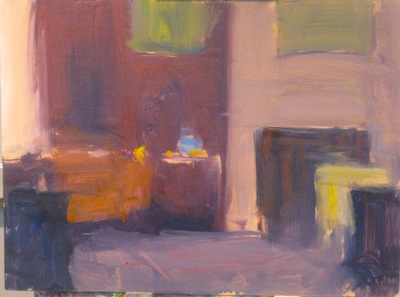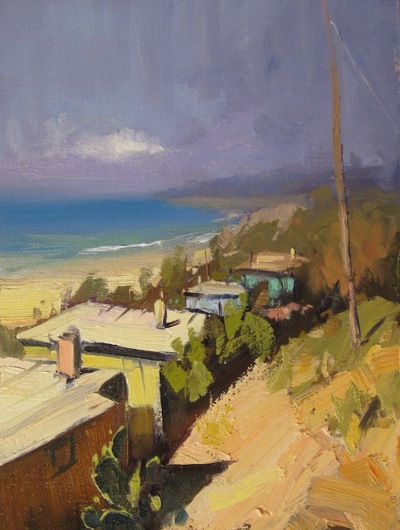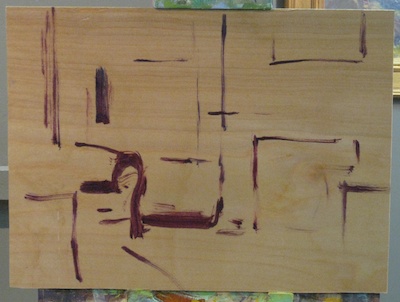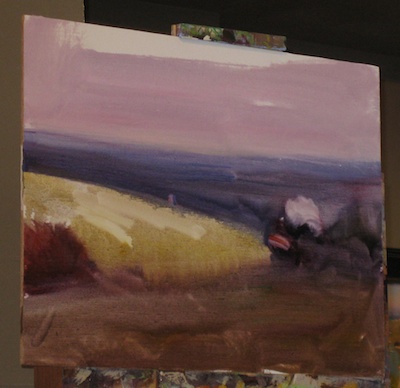
I was once asked to give a talk about “thought leadership” in media. Two creative people I spoke about where Julia Child and Bob Ross. The former revolutionalized American cooking at home by introducing us to the “mystery” of French cooking, and the later did the same for art. I think a lot of artists look down on Bob Ross, and while his painting may not be to your taste, he made art approachable by taking the stress out of it. He de-mystified painting, as Julia did cooking. What does this have to do with Colley Whisson? Two things, first, his manner is calm, re-assuring, yet precise. Second, he’s introduced me—and most people in his workshop—to Australian art as Julia introduced us to French cooking. I hope you make some discoveries, too, after reading this.
Cholley’s Approach
I fouund his approach to be quite similar to other tonalist painters, and in contrast to the Henche school (taught by John Ebersberger, Camille Przewodek, etc). I didn’t get great pictures of any demo start to finish (except for the video below), so the illustrative photographs below go back-and-forth between various demos. I think you’ll still get the general idea.
Materials. Good painting starts with the best materials you can afford. I’ve tried the cheap stuff, and fighting poor quality isn’t worth it, especially when you consider the many challenges you face in bringing together a painting. A couple of notes about his materials:
- Brushes. Two things drew me to Colley’s work: his dramatic sense of light, and his brushwork. Realizing that great brush work has a lot more to do with precision and sensitivity (that only comes with experience), you may want to try these brushes, but don’t expect a miracle. One book dedicated to brushwork I like is Emil Gruppe’s Brushwork for the Oil Painter. It’s out of print, but you can find used copies on Amazon.com. That said, Colley used some brushes I hadn’t seen anyone use before. They look like house painting brushes: quite wide, razer shart, short handle. He uses them both for the first wash-in (see below) as well as throughout the painting to add beautiful calligraphy. Someone told me he used Langnickel 283’s, which apparently you can buy in a three-pack for $15 (I haven’t purchased mine yet, so can’t confirm….I will update this post after I do UPDATE 12/10/2010, from Colley: “Brushes are in a pack of 3: Royal Langnickel “Large Area Brush Set” White Taklon (Medium) Item # RART-150”). He also showed us how to use a razor blade to trim back brushes that are too thick for his technique. Holding the blade with your thumb and forefinger, push the blade down from the ferrule to tip.
- Support. He paints on wood board, Mahogany, I believe. When using canvas, he tones with Yellow Ochre. The board is a good choice for his technique, because he often uses the palette knife to cut-back or trim light colored paint to review dark undertones, a techique he learned from Richard Schmid.
- Medium. He uses an Alkyd medium, but tried Turpenoid during the class and really liked it. He thought it probably dried faster than his usual medium, although he was somewhat concerned about cracking. He said in the past he painted dark undertones/accents with a cool mixture (Utramarine Blue + Alizarin Chrimson), but said that mixed cracked over time. His boards seemed a bit warped, so I wonder if he neglects to prime both sides? In any case, he now ads a Cadium Red to his darks to prevent cracking.
- Rags. Interestingly, he rarely uses paper towels, but instead rags that you can apparently buy in large bags at second hand stores in Australia. I don’t often use rags, but will try it to see if there’s a difference. I do use Viva paper towels exclusively, because they are rag-like and very absorbant. Soneone had blue shop towels with them, and he seemed to like those as well.
Concept. If art is revealing something that’s never been seen or said before, then you should start with a concept (unless you’re painting quick studies to improve skill, like value, drawing, etc). Colley said he paints the picture first in his mind, and things tend to go wrong when you forget that or stray in another direction. There are exceptions. I’m sure we’ve also started with one idea and discovered something new while painting, but I think this idea of keeping the focus on your original impression is good rule of thumb.
Design. Colley starts by marking with dots the vertical and horozontal thirds of the painting surface, and draws a mental (sometimes physical) circle connecting the dots. He believes the center of interest and closely subordinate interests should be within that area. You should also think of the circle in terms of how the eye should move within the painting. Since the subject of composition is so complex, I will refer to the many great books written about composition (eg, Edgar Payne’s Composition of Outdoor Painting is a personal favorite).
Drawing. Start with small dots indicating the boundaries of the large masses. Ensure the relative position, size and shapes are there, then start to draw them in. Like almost any artist I’ve studied with, he emphasized the importance of drawing and doing so whenever/wherever you can. He also demonstrated a nice drawing aid: he uses an thin/light frame as a horizontal and vertical maulstick.
Underpainting. Colley loves strong contrast, so he usually started his paintings with a very dark mixture, although once in a while I noticed he started with midtones, and added dark accents later. He discourages the use of thinner at this point, but rather pure medium (even to clean the brush). In general, I noticed that he tended to paint whole areas dark, even if they would later hold lights. This helps the lights “pop” against the dark background, but of course, this technique requires you give the underpainting time to dry to avoid picking up the underpainting later. I noticed that even with 20 minutes of wait time, my underpainting wasn’t completely dry. He’d often take a paper towel and remove excess underpaint to ensure the next layer could be applied cleanly. This is something I need to continue to experiment with and learn. This may be especially challenging in a “plein air” situation where time is short, so we’ll see. Please share your own experience in comments!
Masses. He’ll first place the lightest light as a small spec of a stroke to ensure it will pop against the dark underpainting. He then focuses on the large color masses, going for accurate value and color on the first stroke (rarely working back in to adjust later). At this point, he stesses an “attack and retreat” technique, ie, lay your strokes in with confidence, and step back often to check your overall color/value relationships.

Painting. He works the canvas all over, drawing the work to completion together, rather than say starting at the center of interest and working outward. He uses the large (4-5″) brushes throughout the painting process, to generate interesting caligraphic strokes and lines using the brush tip. His brush strokes follow the contour of the shape (and not gravity, as some artists like Ken Auster do). He ties the types of strokes he paints in relational to sky (should be a thin veil, like panty hose); mid-field (more texture); and foreground (shag carpet!). As he paints towards completion, he continually asks himself whether the painting is far enough along to communicate his original concept. We all risk taking paintings too far, so I think this is great advice. Let a painting sit a few days before you call it done. He’ll also photograph his work and then flip it on the horizontal axis. This new perspective helps you see mistakes.
Many thanks to The Tucson Art Academy (and their gracious hosts, Gabor and Christine Svagrik) for hosting this workshop, complete with fresh baked scones and cookies! Also, I hope to followup this post with one on the Australian artists Colley referred his students to in class.
Demo (plein air)
While this demo may be helpful, Colley has a wonderful book and DVDs available in International Artist Magazine’s store. You’ll find those much more complete: Impressionist Painting Made Easy; and his various DVDs here.
My Workshop Studies





Love his work
Great contrasts wonderful paint strokes
Very helpful! I’m taking my first workshop with him in September. Thank you for all of this info! Happy Painting 🙂
Great to hear this was helpful. Please tell Colley hello for me. Cheers.
Good concise description. Very useful. I just learned of Colley’s work and have had a great time watching his videos. Thanks for posting. Hope you’re doing well. My daughter just moved to Berkeley!